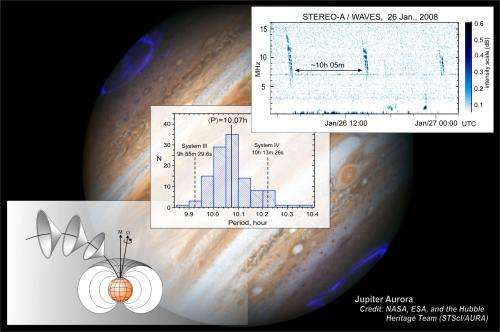"Pirate Broadcaster" on Jupiter—radio emissions conceal surprise

The discovery of a new radio emission from Jupiter is among the highlights of a three-year Austrian Science Fund FWF project. This project actually investigated the planetary radio-frequency emissions of the Earth and Saturn—and a strange radio emission from the planet Jupiter was discovered. Further results of the project, which has now been completed, included the identification of a new modulation in terrestrial radio emissions, as well as analysis of particular components of Saturn's radio emissions. External reviewers assessed the project as outstanding in the closing evaluation.
The Earth is loud—radio-loud. That is how objects causing measurable radio emissions are described in astronomy. The Earth itself is one as well, whose magnet field influences charged particles (electrons, protons, and ions) in a way that causes radio emissions. Indeed, other planets such as Saturn or Jupiter cause these emissions as well. Measuring them allows us to draw conclusions about planetary magnetic fields. A project of the Austrian Science Fund FWF carried out in Graz at the Space Research Institute (IWF) of the Austrian Academy of Sciences had just this goal.
Tuned In
The team headed by Prof. Helmut O. Rucker, Deputy Director and Research Director at the IWF, wanted to analyse specific radio emissions of the Earth and Saturn in cooperation with colleagues from the US and France. And, with the help of radio data from NASA's space probes Stereo-A and Stereo-B, they were successful at this—although a "jammer" had been broadcasting into their work. According to Prof. Rucker: "In the course of the analysis, my colleague, Dr. Mykhaylo Panchenko, discovered a strange radio emission that originated from Jupiter—one which actually would not have been part of our project. That this emission remained undiscovered, despite 50 years of observing Jovian radio emissions, was reason enough for us to get to the bottom of it."
The striking thing about the emission in the decametre region (wavelengths of about 10 metres) was especially its periodicity, that is, the change in its intensity. Up to now, there were two known periods for the decametre emission of Jupiter: one that resulted from the rotation of Jupiter running at 9 hours, 55 minutes, 29.7 seconds (System III), as well as a one further that can be traced back to the influence of Jupiter's moon Io on the magnetic field (42.46 hours). The newly discovered component in the radio emissions, with a period of about 10.07 hours, lay approx. 1.5 percent higher than the one produced by Jupiter's rotation. Dr. Panchenko comments: "Our further analyses suggest that the source of this new radio-frequency component co-rotates with Jupiter. We suspect that the source of the emission lies in the vicinity of the plasma torus fed by Jupiter's moon Io." This is a donut-shaped region around Jupiter that lies at the elevation of Io's orbital plane and has been formed by volcanic material from this moon interacting with Jupiter's magnetic field. This hypothesis about the source and questions about how the radio impulses are created now need to be clarified in future projects.
Projects & Products
Published in Geophysical Research Letters, the work about the discovery of the radio emissions represented an unexpected spin-off product for the FWF project. However, important progress was also made on the radio emissions work actually planned for Earth and Saturn. A distinct diurnal modulation could be established through analysis of the Stereo-A and Stereo-B data for auroral radio emissions of Earth in the kilometre wavelength. In addition, in-flight calibration of the stereo antenna system based on specialised mathematical techniques proved successful. This facilitated an exact characterisation of the reception behaviour of this system. Additionally, accurate analyses of the modulations for Saturn's kilometre-wavelength radio emissions were completed.
More information: Original publication: New periodicity in Jovian decametric radio emission, M. Panchenko, et al.. Geophysical Research Letters, VOL. 37, L05106, DOI: 10. 1029/2010GL042488 , 2010
Journal information: Geophysical Research Letters
Provided by Austrian Science Fund (FWF)



















